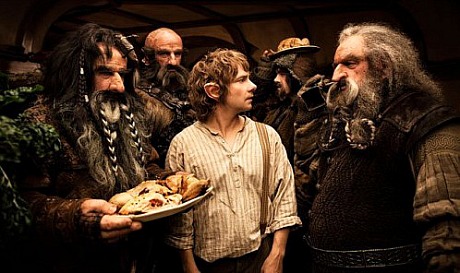The Hobbit‘s review embargo went up an hour ago, and right off the bat I’m reading all kinds of descriptions of how 48 frames-per-second photography doesn’t cut it. It’s too new, too specific, too crackling — a “fiasco,” according to a Movieline headline for a Jen Yamato story. TheWrap‘s Steve Pond called the process “a little disturbing and uncomfortable,” and Variety‘s Peter Debruge said that with 48 fps “everything takes on an overblown, artificial quality in which the phoniness of the sets and costumes becomes obvious.”

And MSN’s James Rocchi tweeted that we can “blame Tolkien for the dull plotting, but blame Peter Jackson for the ruinous 48fps.” Rim shot!
Let me explain something. The 48 fps feeling of discomfort or unfamiliarity, if you insist on that being your primary response, goes away after 20 minutes or a half hour or thereabouts. You get used to it and then it’s nothing. It doesn’t get in the way, it doesn’t call attention to itself — it’s just there. And it’s fine.
Let me explain something else. 48 fps is a lot closer to what life looks like with your eyes. It’s much clearer and sharper and more vivid than 24 fps, which looks like that special neverland called “cinema” — a very peculiar world with very specific climates and textures, and all of it fake. No matter what Pond, Debruge, Yamato and Rocchi are telling you, there’s nothing wrong, trust me, with a movie looking more vivid and life-like and less like the other-worldly realm of 24 fps, which the harumphs prefer because — it really comes down to this — they’ve been watching it all their lives.
All the harumphs really know is that 48 fps ain’t 24 fps, and so they’re saying “eff this noise!” But if you can just roll with the new way and stop having a hissy fit about it not looking like 24 fps, it’s pretty cool. And it’s really ideal for big, empty, drawn-out and wildly bloated movies like The Hobbit because at least it looks so much more gleaming and molecular than 24 fps, like it’s happening on the other side of an absolutely spotless glass window.
Let me explain a third thing. Once you’ve seen a big, empty, splashy, FX-driven film at 48 fps, you’ll never again be fully satisfied with seeing a big, empty, splashy, FX-driven film at 24 fps. 48 fps is perfect for comic-book whack-offs, Star Trek or Star Wars flicks, monster movies, vampire movies, pirate movies, adventure flicks, zombie flicks, animated features…anything that isn’t straight drama or any kind of impressively written, character-driven adult fare aimed at anyone with a year or two of college.

My personal preference is that straight adult fare should be shot at 30 fps because it looks a lot cleaner than 24 fps and reduces pan blur and makes the action seem smoother. And all the rest of the films (i.e., those described above) should be shot at 48 fps. And believe me, the harumphs will eventually ease up and settle in.
As for The Hobbit itself, it’s a major slog. I began looking at my watch at the 25-minute mark, at which point I moaned and muttered to myself, “God…over two hours to go!” It’s like being on a long dull plane ride to Alaska without wifi. It’s ponderous, meditative and glacially paced, and sporadically or episodically cranked up in the usual Jackson style. The acting is always broad (except for Martin Freeman‘s low-key Bilbo Baggins), but everything is always frenzied and amplified and compounded with the heroes facing terrible, insurmountable odds, and the action scenes always ending in a cliffhanger with the “oh my God!” rescue never happening until the very last second, and with nobody “good” ever getting seriously hurt, much less killed. They might be unconscious and look dead, but they’ll wake up sooner or later.
I knew it would be like this, and it was. Tolkien’s “The Hobbit” was a relatively slim volume but Jackson has turned it into a big lumbering trilogy. I really can’t bear the idea of watching two more three-hour-long Hobbit flicks…and I don’t think I will.









